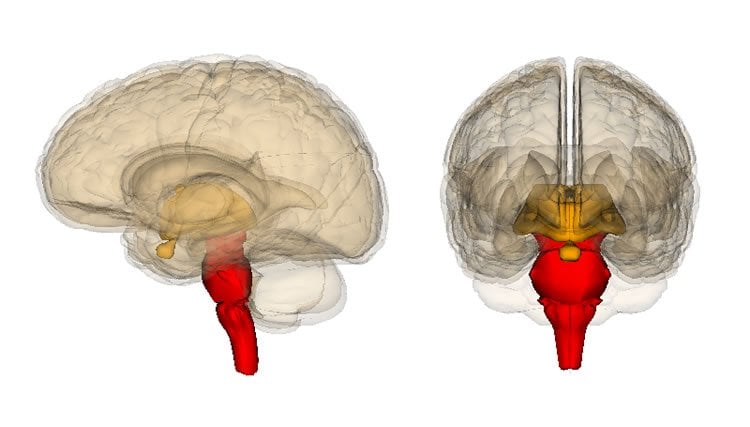A population of ‘stop cells’ in the brainstem is essential for the ability of mice to stop their locomotion, according to a new study by scientists at Karolinska Institutet in Sweden. In an article published in the journal Cell, they report a brainstem pathway specifically dedicated to enforce locomotor arrest; its selective activation stops locomotion, while its silencing favors it. The study thus identifies a novel descending modality essential for gating the episodic nature of locomotor behavior.
Locomotion is an essential motor behaviour needed for survival in both humans and animals. It has an episodic nature: we move when we want or need and, equally well, we can terminate ongoing movements. This episodic control has generally been attributed to descending excitatory signals in the brainstem that contact and activate neuronal circuits in the spinal cord. But is the stop of locomotion only due to a lack of activating signals from the brainstem or is there a dedicated stop signal?
In the present study, the researchers Julien Bouvier and Vittorio Caggiano together with Professor Ole Kiehn and colleagues studied how the complex brainstem neuronal circuits control locomotion in mice. They used advanced methods, including optogenetics, which makes it possible to selectively activate specific groups of neurons with light, as well as genetic silencing to selectively block neuronal activity.
Somewhat unexpectedly, they found a population of excitatory neurons that turned out to be essential for the ability of mice to stop. When those ‘stop cells’ are activated, mice immediately halt their locomotion. Conversely, when those neurons are silenced, mice had difficulties when trying to stop walking.
“We found that the stop cells depress the neuronal networks involved in generating the locomotor rhythm, the clock in the network, and not the motor neurons that directly contract muscles”, says Ole Kiehn, who leads the laboratory behind the study at Karolinska Institutet’s Department of Neuroscience. “In this way activity in the stop cells allows the animal to make a gracious stop without losing its muscle tone, just as we experience ourselves when we voluntarily stop for example in front of an obstacle.”

Although the study addresses the normal brain function the findings may provide insights to how locomotion is affected in the diseased brain.
“For example, in Parkinson’s disease, a pronounced motor symptom is a gait disturbance with freezing of the gait”, says Ole Kiehn. “t is possible that the stop cells have an abnormally increased activity in Parkinson’s disease, contributing to the gait disturbances.”
Funding: The study was financed with grants from the Swedish Brain Foundation, the Söderberg Foundations, the Swedish Research Council, the European Research Council, an EMBO fellowship, and by the NIH.
Source: Karolinska Institute
Image Credit: The image is credited to Life Science Databases (LSDB) and is licensed CC-BY-SA-2.1-jp
Original Research: Abstract for “Descending command neurons in the brainstem that halt locomotion” by Julien Bouvier, Vittorio Caggiano, Roberto Leiras, Vanessa Caldeira, Carmelo Bellardita, Kira Balueva, Andrea Fuchs, and Ole Kiehn in Cell. Published online November 19 2015 doi:10.1016/j.cell.2015.10.074
Abstract
Descending command neurons in the brainstem that halt locomotion
Highlights
•Mouse V2a brainstem neurons are excitatory and project to the ventral spinal cord
•Optogenetic activation of V2a neurons of the rostral medulla halts locomotion
•These “V2a stop neurons” act by depressing locomotor rhythm generation
•V2a stop neurons are needed for episodic locomotion
Summary
The episodic nature of locomotion is thought to be controlled by descending inputs from the brainstem. Most studies have largely attributed this control to initiating excitatory signals, but little is known about putative commands that may specifically determine locomotor offset. To link identifiable brainstem populations to a potential locomotor stop signal, we used developmental genetics and considered a discrete neuronal population in the reticular formation: the V2a neurons. We find that those neurons constitute a major excitatory pathway to locomotor areas of the ventral spinal cord. Selective activation of V2a neurons of the rostral medulla stops ongoing locomotor activity, owing to an inhibition of premotor locomotor networks in the spinal cord. Moreover, inactivation of such neurons decreases spontaneous stopping in vivo. Therefore, the V2a “stop neurons” represent a glutamatergic descending pathway that favors immobility and may thus help control the episodic nature of locomotion.
“Descending command neurons in the brainstem that halt locomotion” by Julien Bouvier, Vittorio Caggiano, Roberto Leiras, Vanessa Caldeira, Carmelo Bellardita, Kira Balueva, Andrea Fuchs, and Ole Kiehn in Cell. Published online November 19 2015 doi:10.1016/j.cell.2015.10.074






